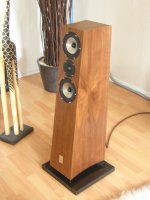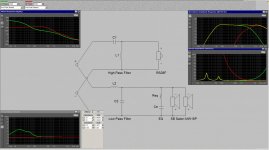I really freaked out an experienced CNC operator with a cab that was, well it was a bit more involved than this one actually- compound angles are frequently terrifying even for quite experienced woodworkers, even with CNC machines!
What an awesome shape- I love it.
What an awesome shape- I love it.
Given the lengths of the edges, that can't be covered with a plain sheet. You would have to bend it.
Yes, a plain single sheet is nearly impossible. Strange, at first i thought it could be done.
Usually ideas like that come to me in the morning when i wake up. Is it so bad that i even design in my dreams ?
Usually ideas like that come to me in the morning when i wake up. Is it so bad that i even design in my dreams ?
No, it is a bass reflex, tube to the back. I thought that an inwards bend is more stable to inside pressure then the more usual outside bend like popularized by Sonus Faber.
Like a water dam that is bend against the water. The cabinet gets more narrow to the top and is angled by 7°. That gives a measure of delay alignment and reduces diffraction effects.
Like a water dam that is bend against the water. The cabinet gets more narrow to the top and is angled by 7°. That gives a measure of delay alignment and reduces diffraction effects.
Why doesn't it act as an organ pipe? Or does it (it must, right?) and you're compensating for that somehow? I've been trying to make a tall bass reflex like that and coming to terms with the organ pipe issues, in theory, anyway...
I just now noticed the curved wood. Wow! I'd think they're would be a couple hot spots on either side where the convex surface focuses the sound at some frequency or another.
I just now noticed the curved wood. Wow! I'd think they're would be a couple hot spots on either side where the convex surface focuses the sound at some frequency or another.
The Aquilla is vertically divided into three damped chamber so the vertical resonance is suppressed. The cabinets have being manufactured by Hornslet in Denmark. They have a patent on bended or curved cabinets. Actually they are not easy to manufacture.
They have a patent on bended or curved cabinets. Actually they are not easy to manufacture.
I imagine not! Then again, people make snare drums all day long...
Yes, ones you have ramped up production you can do any shape i suppose. Building a sucessfull loudspeaker cabinet, one that sounds good, requires special skills though. I thought about a solution that is easier to make then post 12 and i will draw that up when i come home. Still i will also follow the design in post 12m so we have two alternatives.
Tomorrow i will measure the drivers in a 1,2m x 1,2m standart baffle. I will measure amplitude response ( on and off axis ) and phase. Also acoustic center and distortion.
Interesting design of the crossover with the mid woofers reversed in phase. I think you used the 8 Ohm version of the mid woofer.
You get a flat impedance curve and a flat amplitude curve. Over 200 Hz the group delay looks great too. Very inspiring.
You get a flat impedance curve and a flat amplitude curve. Over 200 Hz the group delay looks great too. Very inspiring.
Yes, I used the 8Ω version.
Do we yet know if these woofers are going to hit the similar $65usd price point of other similar sized SB Acoustic midwoofers?
Crossover costs with good components only runs $80usd, This could be a really nice affordable TWW setup.
Do we yet know if these woofers are going to hit the similar $65usd price point of other similar sized SB Acoustic midwoofers?
Crossover costs with good components only runs $80usd, This could be a really nice affordable TWW setup.
Last edited:
No, they are rather more expensive, sorry. At this moment i only know the retail price in Germany so i have to check what they cost in the US. I do not know the price of the tweeter yet but i can find that out for you.
My plan was to start with a L/R 4th order and then work down to Butterworth 3rd and L/R second. Ultimately i could try your Bessel approach or even first order.
In general i found that less components in a passive crossover sound better when certain limits of linearity and lobing are met. About the audibility of phase distortion a lot has being said but none conclusive. I made my own experiments in the 90th when we constructed a DSP based speaker at the University of Essex where we could switch between an L/R4 and the phase linear version of it without changing the frequency response and the lobing. That is a long story and i may tell more about it. In the meantime here is a primer on L/R networks :Linkwitz-Riley Crossovers: A Primer
My plan was to start with a L/R 4th order and then work down to Butterworth 3rd and L/R second. Ultimately i could try your Bessel approach or even first order.
In general i found that less components in a passive crossover sound better when certain limits of linearity and lobing are met. About the audibility of phase distortion a lot has being said but none conclusive. I made my own experiments in the 90th when we constructed a DSP based speaker at the University of Essex where we could switch between an L/R4 and the phase linear version of it without changing the frequency response and the lobing. That is a long story and i may tell more about it. In the meantime here is a primer on L/R networks :Linkwitz-Riley Crossovers: A Primer
Last edited:
- Home
- Vendor's Bazaar
- SB Acoustics Satori Monitor

